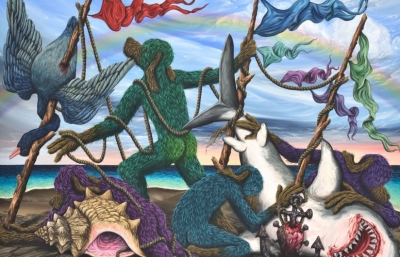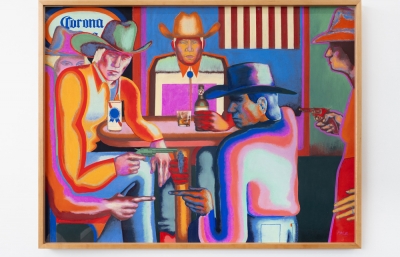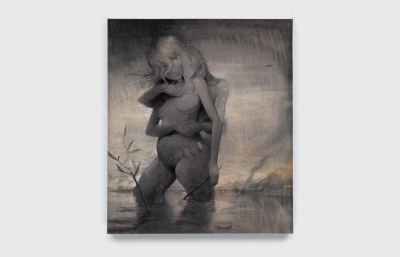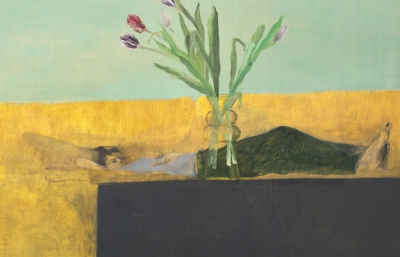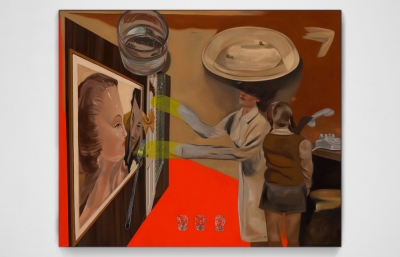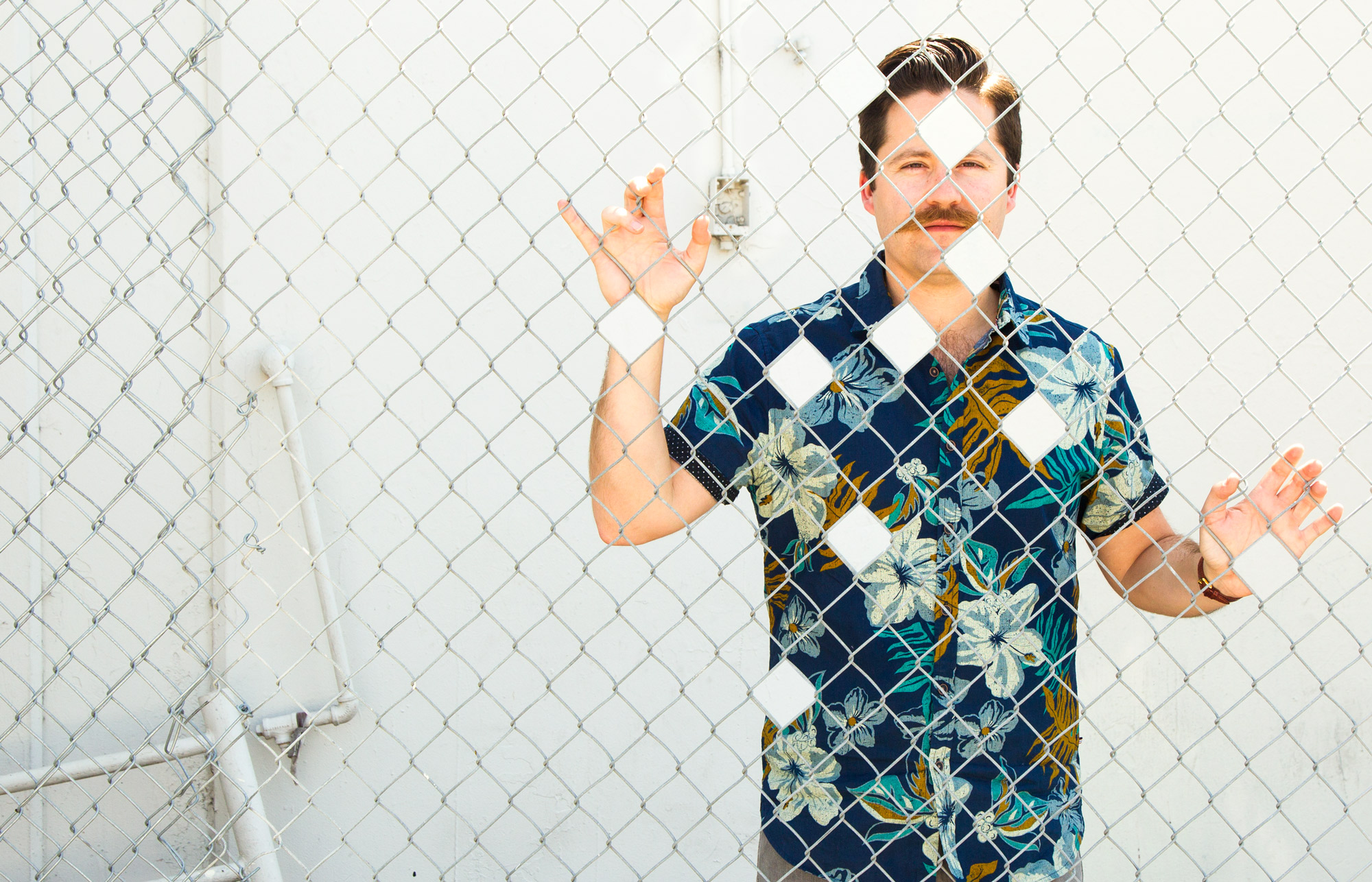
Beau Stanton
Machine Dreams
Interview by Evan Pricco // Portrait by David Broach
Beau Stanton began painting as a 10-year-old growing up in Orange County, California. There are many reasons why this is fascinating, even charming, but one of the things that always intrigued me about this fact is the Orange County element of the revelation. Looking at his art, whether it be paintings, murals, mosaics, or animations, I see an artist who should have been raised in the post-industrial heartland. Gears, ships and relics of the great American past are used with a classical decorum not generally associated with the heyday of California’s architectural vision.
Though this is the first time that there’s ever been a recorder between us, Beau Stanton and I have had this conversation before; a discussion of history and a particular story of America’s industrial wealth and the remains we still see today, the ornate structures we built, and the vestiges that survive. Detroit is the place for the definitive interview where Beau has created incredible mosaics from the stone, brick, ceramic tile and glass found in abandoned buildings, perfect for his residency and exhibition at Red Bull’s House of Art. This is a city that speaks to his work and informs his thought process more than any place at this point in his career.
Evan Pricco: Let’s start with Detroit, since we're here. You and I both grew up in California, a place that doesn’t necessarily have the antiquated architecture, or represent the grandiose era of American power and wealth like Detroit. I'm curious how you got interested in this period of American history, because I know this city really inspires you.
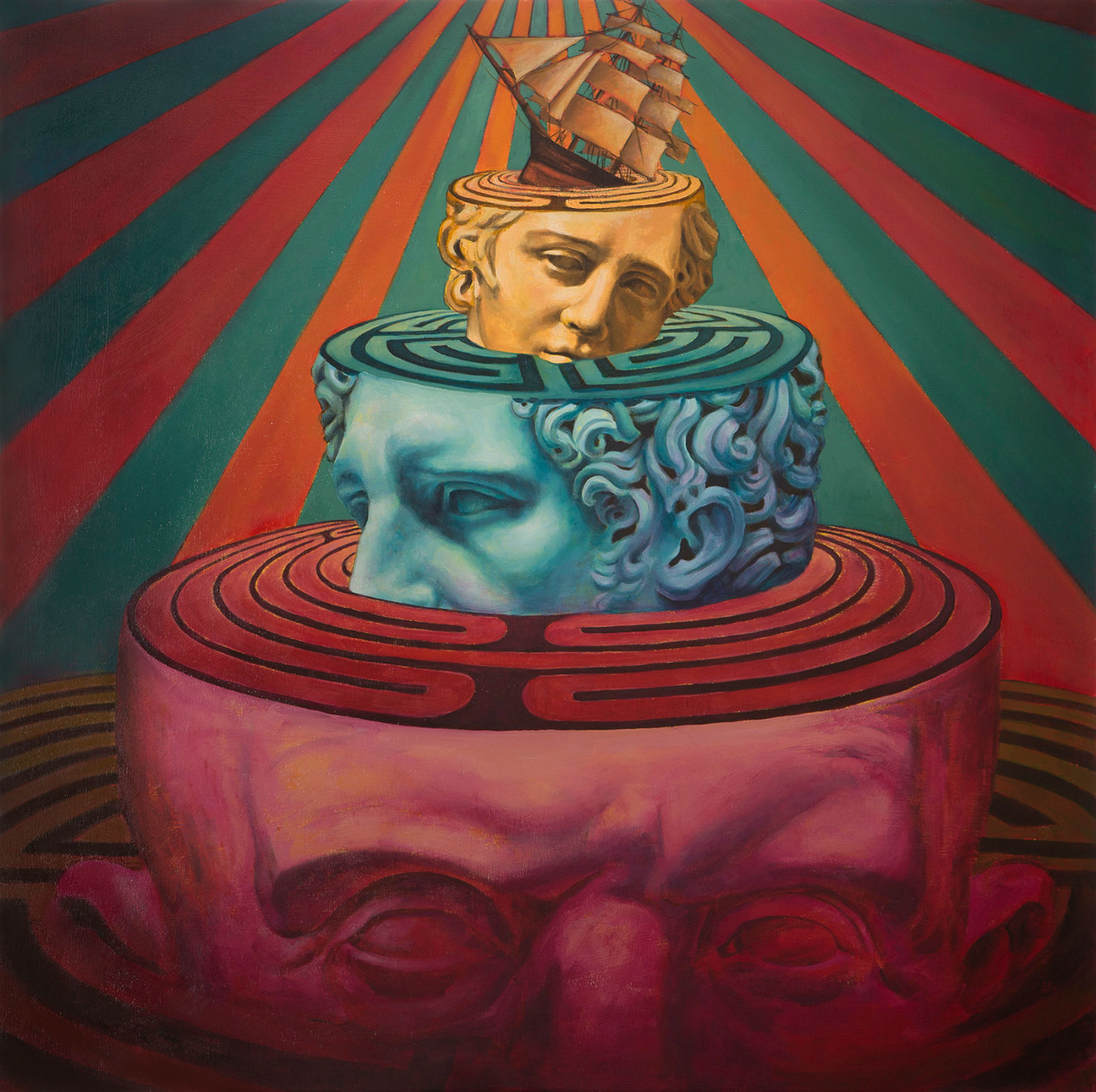
Beau Stanton: I've always been really obsessed with history, and have a really romantic obsession with Detroit, in particular, but also cities that have a lot of those layers of history, architectural styles, and ornamentation. I think that the first time I came to this city, I was especially taken with the iconic quality, because everybody knows Detroit; it is this quintessential example of what the American dream is supposed to be. Clearly, it has experienced some trouble in the past two decades, but I really liked seeing such evidence of riches and success. A lot of it has crumbled, but a lot of it's still here, and there's such great energy to be seen rising out of the ashes, particularly with artists. All that put together, I was immediately taken by this place and it's like nowhere else, really.
Having known you for years now, I recognized your keen eye for those details even before you came to Detroit, even before you got this residency at the Red Bull House of Art.
I think being in New York had a lot to do with that. I really developed the visual language living there, just that sense of history. I think I was really drawn to it because growing up in the coastal suburbs of Southern California, you don't feel any of that industrial history.
I guess you said it—California, for the most, part doesn't have as much history as those other places. I was being a little harsh on California a second ago, but you got me.
Right. It's not as obvious like Detroit or NYC. It's not like there's a downtown where I grew up where you can see these monolithic monuments built in the early 20th Century. Obviously California has got a very interesting, rich history; it’s just not as visually obvious. It’s more of a feudal place. Being in New York, I started becoming really obsessed with architectural ornamentation, and then I started referencing it in different places, like a brass door handle, or even a plate or something, and I started compiling a little library of all that stuff. That’s when I started mixing them into the paintings I was making.
But I was taking that ornamentation and putting it in places you wouldn’t see, like in waves of the ocean, or in compositions that go around and render the painted elements of my work. I’m always looking for that stuff, whether I’m conscious of it or not, so when I go to a city like Detroit, it’s everywhere! Even if it’s crumbling, there’s an even more interesting beauty, and then it’s so rich, it’s a very fertile ground for sourcing this.
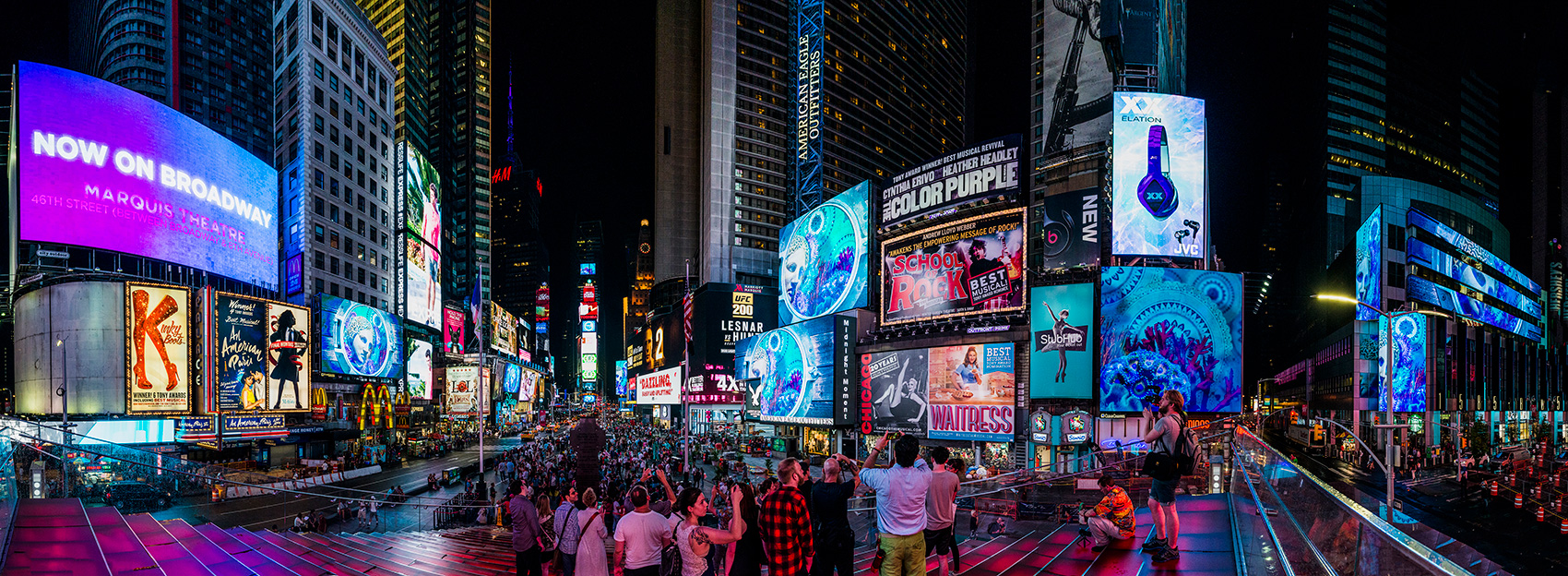
But you have sort of meshed your observations with your own original style and palette.
I had pretty academic training in drawing and painting, so if trained correctly, you’re supposed to observe, and paint from your observations. I guess that’s probably ingrained in me a little bit, but going from that step to visualizing your own image, or composing an image, it’s a totally different process, right? If you can be trained to paint from something that you’re looking at, then you are free to flip the switch and make it subjective. That took a little longer to figure out.
What does working in a studio with another artist teach you? For years, you were working in Ron English’s studio, and I wonder, just on a day-to-day schedule, how much you were able to learn.
A lot about technique in particular, but also just broadening horizons of what art is, or what art could be, you know? When I moved to New York, all I thought I could really do was draw and paint, and that’s what I was going to be. Be a painter, and that’s it. Working around other artists that cross into other media, I realized that, if you’re an artist, you don’t have to just paint. You don’t have to just do one thing! If you have a vision, you can translate it into all kinds of things, and in fact, it’s far more interesting, and I think that’s definitely the way art has become. You can see this in a lot of artists who are making things that are more environmental, something you can experience beyond just the two-dimensional thing framed on the wall. That’s one of the biggest things I gained from working around other artists, particularly working with Ron. But even in this residency here, we’re all sort of feeding off of each other’s energy. Like, “Oh, really? You’re going to play with that media? I should try something weird, too …” Now it’s really a part of my practice.
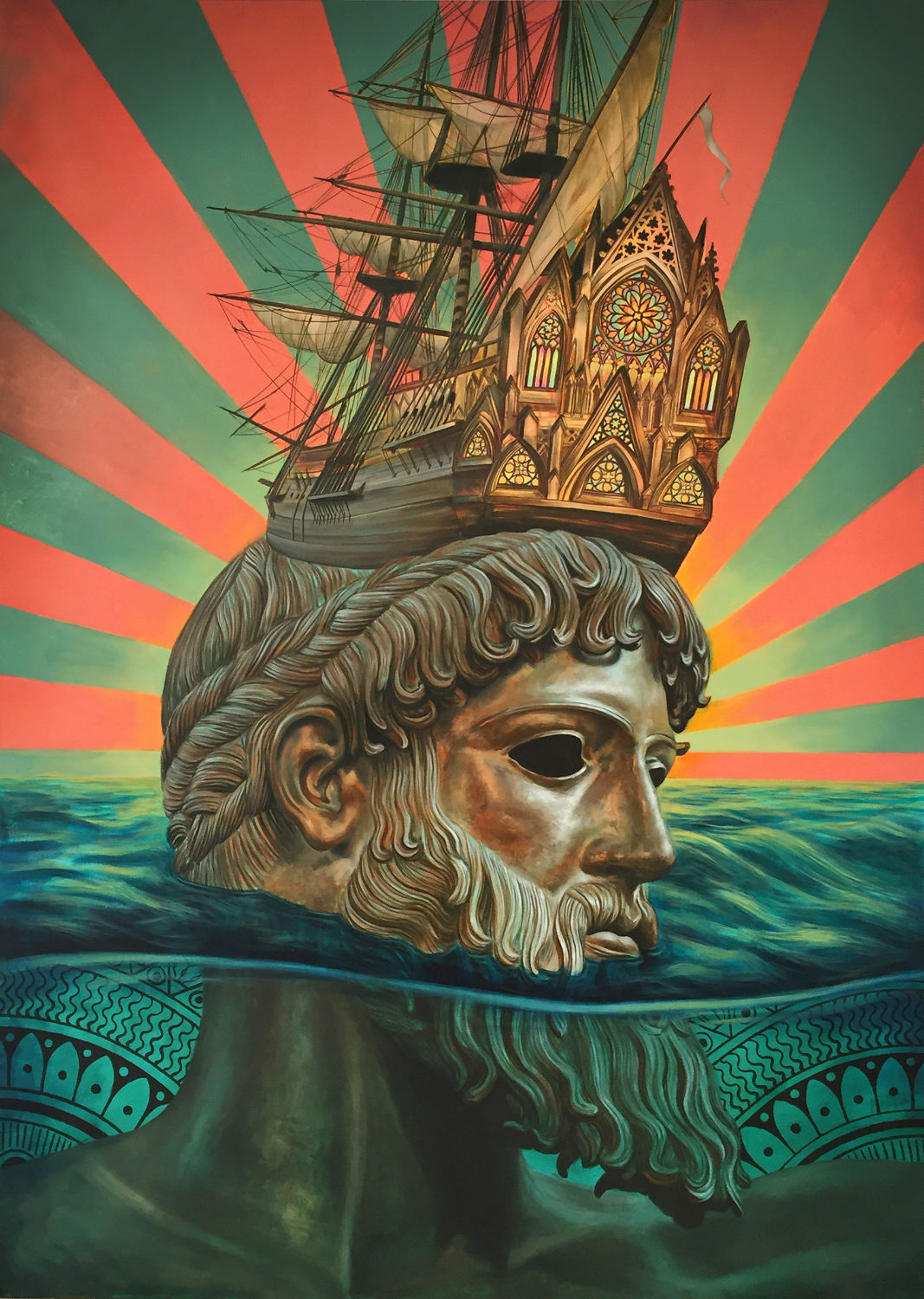
I’m a painter; that’s been my bread and butter. However, I couldn’t just go back to just doing painting. I’m constantly wanting to translate what I’ve done in painting, and then push it by making stained glass, or mosaics, or multimedia animations, or just plain old murals. A mural that becomes a third dimension, because the wall is all wonky and has these angles, that really stimulates me. I love making two-dimensional work, but I get really excited when I have to solve a problem, because I don’t know how to quite make it manifest in the world yet. Being able to go through that process, the intersection of problem-solving and actually having things work, that’s one of my favorite parts about making art.
It does feel right now that it’s a good time to be sampling different genres. Audiences, even if you don’t make art for them, per se, are fascinated by how artists, as you said, can apply their signatures to these different environments. But I didn’t even think of the residency aspect, where you can literally experiment with others and have a dialogue in real time.
There are definitely more artists than there have ever been, right? And certain art movements have been pushed aside because people in the mainstream don’t accept them as fine art. And I think that is changing. I think a lot of art is being brought into the mainstream, and really being accepted and thought about more seriously. For instance, illustration, or anything related to illustration, was considered lowbrow, and now there’s a whole thriving industry around it. Sequential art or graphic novels, the same thing. I think that, when artists want to diverge off the main path to do these other things, it gives it more credibility. So yeah, it’s a great time for a lot of art.
Something cool in this residency is the really detailed, painstakingly processed mosaics. For someone who does a lot of different kinds of work, you had to focus on one style for 90 days. That has to be interesting for you, maybe even a tad difficult?
For myself, I’m enjoying opening it up to different crafts, and spending three months doing one project here in Detroit is really advantageous. I was making these mosaics where I didn’t even pick up a paintbrush the entire time, and then I went to paint a mural and it felt great! It felt amazing, because I really did miss that. But it’s nice to be able to mix up the processes because they actually inform each other. What I was doing in mosaic, and having to squint, and use each stone just to get the right value, and compose the image like that, it was almost like little paint swatches. It was almost like a weird exercise in painting, and then, when I actually went back to painting, whether I realized it or not, I approached the work with a new perspective. All these visual mediums, they cross over, and then the principles are the same. It would be interesting to see, over greater time, how the other work changes because of the interplay.
Was art school helpful for you?
Yeah, in a lot of ways. I think people make the mistake of expecting that they’re going to be a fully-formed artist when they get out of art school, and that’s just not even close. I really honed my skills, which was really important, and obviously, I’m very obsessed with processing everything around me into my work. It’s not the end-all goal. I mean, there are ideas and narratives behind the work, but my primary concern is the process.
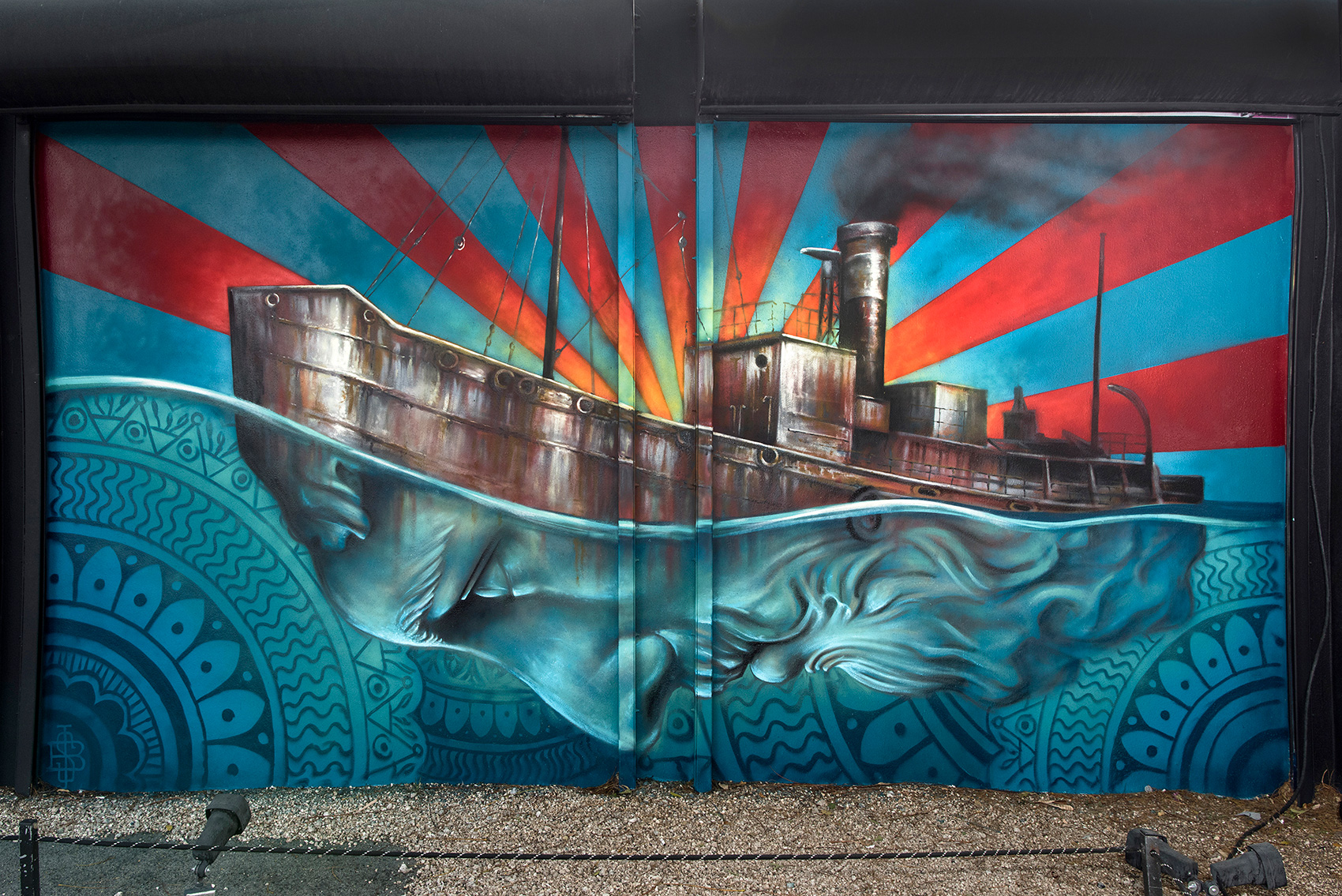
I learned how to draw and paint in school. I got a lot of good skills out of it; however, it’s not enough. You need experience in the actual world, and working with some established artists after school was really, really fundamental. But I had those foundational skills, and then I got a taste of the real world, and what it takes, and what’s possible. You really have no concept of how the art world works until you see what other people are doing in their studios as professionals.
What was the 10-year-old creative Beau Stanton like?
That was when I started oil painting.
Really? Wow, that seems young to me!
It dawned on me the other day that I’ve been regularly, seriously oil painting for more than twenty years, which is crazy to think about. I was a weird kid. I wasn’t into sports. I guess I was an inside kid. I liked painting and I played the violin.
I knew there was a reason I liked you.
I was already sure I was going to be an artist. I don’t remember a time when I didn’t think I was going to be an artist.
Did you have family that was into it?
Both my parents are creatively inclined. My dad studied photography at Brooks Institute and my mom was always drawing, so they always encouraged me with the arts. You know, I think every kid starts out wanting to draw. Every kid does it in some way, it’s just part of being a human being. Everyone wants to create something at some point, and some get obsessed and probably nurtured where a teacher or parent or friend said, “Keep doing this!” I was lucky enough to have that.
Was it really clear for you, early on, that you were good at art, and that you were not going to be a mathematician?
It was always a part of my identity. I remember being a little kid and drawing superheroes.
You have really identifiable characteristics in your work, especially your color palettes.
I think that’s an important part of the work I’m doing, this evolution into a specific visual language. That’s not always the endgame for an artist. Sometimes it’s about the experience with the art, and less about the immediate, visceral, visual identification.

What did the work look like when you were twenty?
There’s actually a lot of common threads. I always liked the work I was making in college, like my thesis show. I look back on it now, and there were a lot of gears and figures. and it wasn’t too far off from what I‘ve become.
The gears show up in your animation work, and your paintings, too?
Even those circular pattern things are supposed to be big cogs in a machine. Just the idea of the mechanics underneath something, or metaphorical mechanics. I was always interested in that kind of texture of decaying; decaying mechanics or infrastructure, even in like a metaphoric sense, and the colors that would come out, the patina of coppers. That’s obviously been a common thread. The work has gone from just purely observational painting to these surreal environments.
Do you at all feel connected to a specific genre? I know working for Ron English, you saw someone who was connected to lowbrow, street art, activist art and related products. But do you feel connected to lowbrow or street art at all?
It has definitely influenced how I’ve worked with paint. However, I’m trying to walk a line of more broadly going into the contemporary world without being necessarily categorized. I think some people are probably content with saying, “I’m a pop-surrealist painter,” but if I have to have a little blurb, I say I’m a multidisciplinary artist. Then people ask what I do. Well, I’m a painter, and a muralist. I like to do public art. It’s a big part of my practice. I translate what I do visually into multiple mediums. Once I figured out that I could do that, it was very freeing.

When you did the Times Square Midnight Moment, in the summer of 2016, and had all the screens projecting your animation, how surreal was that?
I never got used to it.
How many times did you go see it?
I think I went about 10 times. I would have gone more, but I had to go to the West Coast at some point. I really, really enjoy having art in unexpected places. You don’t just need the white wall space. Those galleries serve a great purpose, but it’s more exciting, and I think the viewer responds more to unexpected art happenings. Here’s a couple reasons: I think for the casual art observer, being in a gallery could make you nervous because you are expected to buy something. When the unexpected happens, you can experience it on your own terms. You don’t even know you’re going to experience it. When you walk to work, and you come upon a mural, or some sort of street intervention, it’s the surprise factor. Just the fact that it can be experienced in your everyday life…
beaustanton.com

